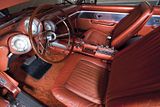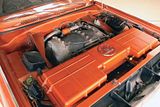Called “one of the greatest publicity stunts in automotive history,” the Chrysler Turbine car program certainly also ranks as one of the most unique automotive experiments, and its story continues to captivate today, 50 years later. By the spring of 1963, Chrysler’s experiments with turbine-powered cars were rather well known, not the least bit because Chrysler had over the prior decade fitted some of its products with turbine engines and driven them across the country. Of course, Chrysler wasn’t the only automaker looking into the technology – GM, Ford, Fiat, Kenworth, and many others all investigated turbines, and the press of the day frequently heralded the coming of the turbine car and subsequent death of the reciprocating-piston engine – but Chrysler was the only automaker to take the next logical step and start to develop a turbine-powered car that it would make available to the public. So in May of 1963, Chrysler not only introduced the Turbine car, it also announced that it would make 50 of the cars available for three-month-long test drives. Designed by Elwood Engel and ushered along by Chrysler’s chief engineer of research and development, George Huebner, the Turbine cars featured two-door four-passenger sedan bodies built by Ghia that shared almost nothing with any other Chrysler Corporation product. Under the hood, they featured Chrysler’s fourth-generation A-381 regenerator turbine engine, good for 425-pound-feet of torque, hooked up to modified TorqueFlite three-speed automatic transmissions. The unitized chassis departed from standard Chrysler torsion-bar suspension up front and used coil-spring front suspension. Aside from the five prototypes built by Ghia, all 50 came in the same configuration: bronze paint, black vinyl top, and bronze leather interior. After the announcement, more than 30,000 volunteers sent Chrysler unsolicited requests to become test drivers. Starting that October, Chrysler then chose from those volunteers to drive 46 of the 50 test-drive cars (two were sent to the 1964 World’s Fair in New York, and two were designated for other Chrysler publicity purposes) for three-month stints, provided that the volunteers not only give maximum exposure to the cars, but also provide detailed feedback at the end of the test drive. Chrysler would cover all maintenance costs, registration, and insurance during those three months; the test drivers had only to pay for fuel, which tended to be either diesel, kerosene or unleaded gasoline (the cars would run on leaded gasoline, but Chrysler found that the lead damaged the turbine engines). More than two years later, Chrysler brought the program to an end after lending the Turbine cars to 203 volunteers. Responses were generally positive, as Steve Lehto wrote in his book Chrysler’s Turbine Car: The Rise and Fall of Detroit’s Coolest Creation. Most of the drivers appreciated the turbine engine’s smooth operation and reduced maintenance requirements, but some did complain about the poor fuel economy and the lazy acceleration from a standing start. Just as important as the feedback, Chrysler’s engineers were also able to identify and fix some critical issues with the turbine engine that would only come to light with extensive road testing. However, despite requests from those very same test drivers and many others to put a turbine-powered car into wider production (Chrysler reportedly briefly considered doing so with the car that eventually became the Dodge Charger), Chrysler ultimately decided to stick with traditional piston engines for its production vehicles, though it did continue the turbine engine program into the early 1980s. As for the 55 total Turbine cars, Chrysler kept three, donated six to museums, and destroyed the other 46 in 1966, largely because the company feared that if it let the cars filter into the public’s hands, untrained mechanics wouldn’t properly service the turbine engines, resulting in poor reputations for the engines. Nowadays, Chrysler still owns two of its Turbine cars, five Turbine cars remain in museums – the Henry Ford, the St. Louis Museum of Transportation, the Petersen Automotive Museum, the Smithsonian, and the Detroit Historical Museum – and two Turbine cars have made their way into private hands (Jay Leno bought one of the three Chrysler held on to, while Frank Kleptz owns the one initially given to the Harrah collection). As of this writing, the only celebration of the Turbine’s 50th anniversary we’ve seen is a half-hearted tribute by Chrysler, a V-6-powered 300S painted in a matte bronze with one-off turbine-spoke wheels. For more on Jay Leno’s Chrysler Turbine and on the Chrysler Turbine in general, check out the October 2012 issue of Hemmings Classic Car. Source: Hemings Blog Links |
|





